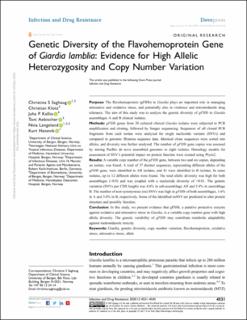| dc.description.abstract | Purpose: The flavohemoprotein (gFlHb) in Giardia plays an important role in managing nitrosative and oxidative stress, and potentially also in virulence and nitroimidazole drug tolerance. The aim of this study was to analyze the genetic diversity of gFlHb in Giardia assemblages A and B clinical isolates.
Methods: gFlHb genes from 20 cultured clinical Giardia isolates were subjected to PCR amplification and cloning, followed by Sanger sequencing. Sequences of all cloned PCR fragments from each isolate were analyzed for single nucleotide variants (SNVs) and compared to genomic Illumina sequence data. Identical clone sequences were sorted into alleles, and diversity was further analyzed. The number of gFlHb gene copies was assessed by mining PacBio de novo assembled genomes in eight isolates. Homology models for assessment of SNV’s potential impact on protein function were created using Phyre2.
Results: A variable copy number of the gFlHb gene, between two and six copies, depending on isolate, was found. A total of 37 distinct sequences, representing different alleles of the gFlHb gene, were identified in AII isolates, and 41 were identified in B isolates. In some isolates, up to 12 different alleles were found. The total allelic diversity was high for both assemblages (> 0.9) and was coupled with a nucleotide diversity of < 0.01. The genetic variation (SNVs per CDS length) was 4.8% in sub-assemblage AII and 5.4% in assemblage B. The number of non-synonymous (ns) SNVs was high in gFIHb of both assemblages, 1.6% in A and 3.0% in B, respectively. Some of the identified nsSNV are predicted to alter protein structure and possibly function.
Conclusion: In this study, we present evidence that gFlHb, a putative protective enzyme against oxidative and nitrosative stress in Giardia, is a variable copy number gene with high allelic diversity. The genetic variability of gFlHb may contribute metabolic adaptability against metronidazole toxicity. | en_US |

